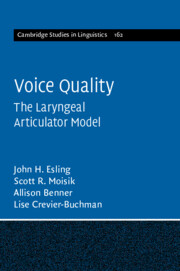Book contents
- Voice Quality
- Series page
- Cambridge Studies in Linguistics
- Voice Quality
- Copyright page
- Contents
- Figures
- Tables
- Preface
- Acknowledgements
- Abbreviations
- 1 Voice and Voice Quality
- 2 Laryngeal Voice Quality Classification
- 3 Instrumental Case Studies and Computational Simulations of Voice Quality
- 4 Linguistic, Paralinguistic, and Extralinguistic Illustrations of Voice Quality
- 5 Phonological Implications of Voice Quality Theory
- 6 Infant Acquisition of Speech and Voice Quality
- 7 Clinical Illustrations of Voice Quality
- 8 Laryngeal Articulation and Voice Quality in Sound Change, Language Ontogeny and Phylogeny
- References
- Author/Artist Index
- Subject Index
8 - Laryngeal Articulation and Voice Quality in Sound Change, Language Ontogeny and Phylogeny
Published online by Cambridge University Press: 21 June 2019
- Voice Quality
- Series page
- Cambridge Studies in Linguistics
- Voice Quality
- Copyright page
- Contents
- Figures
- Tables
- Preface
- Acknowledgements
- Abbreviations
- 1 Voice and Voice Quality
- 2 Laryngeal Voice Quality Classification
- 3 Instrumental Case Studies and Computational Simulations of Voice Quality
- 4 Linguistic, Paralinguistic, and Extralinguistic Illustrations of Voice Quality
- 5 Phonological Implications of Voice Quality Theory
- 6 Infant Acquisition of Speech and Voice Quality
- 7 Clinical Illustrations of Voice Quality
- 8 Laryngeal Articulation and Voice Quality in Sound Change, Language Ontogeny and Phylogeny
- References
- Author/Artist Index
- Subject Index
Summary
Chapter 8 summarizes the ramifications of the Laryngeal Articular Model for the phonetic description of voice quality and investigates its place in phonetic theory. Predispositions for background voice qualities to underlie different vowel qualities are identified. It is argued that there is a parallel between the coarticulatory path that infants follow in their earliest speech development and elements in the process of phonetic sound change. The laryngeal articulator as an enabler of sound change is explored. Theories of ontogenetic speech development are reviewed (concepts of ‘speechlikeness,’ autogeneration, frame/content, cyclicity, reduplication, variegation) and reinterpreted to reflect the scope of laryngeal behaviour outlined in this volume. The discussion evaluates the implications of the revised view of laryngeal phonetic behaviour for the phylogeny of human speech. The physiology of the larynx is shown to permit a wider range of speech production than formerly assumed and to accommodate, on phonetic grounds, an earlier time period for the appearance of speech in human ancestors, as hypothesized in recent anthropological and genetic research.
Keywords
Information
- Type
- Chapter
- Information
- Voice QualityThe Laryngeal Articulator Model, pp. 239 - 256Publisher: Cambridge University PressPrint publication year: 2019
Accessibility standard: Unknown
Why this information is here
This section outlines the accessibility features of this content - including support for screen readers, full keyboard navigation and high-contrast display options. This may not be relevant for you.Accessibility Information
- 1
- Cited by
